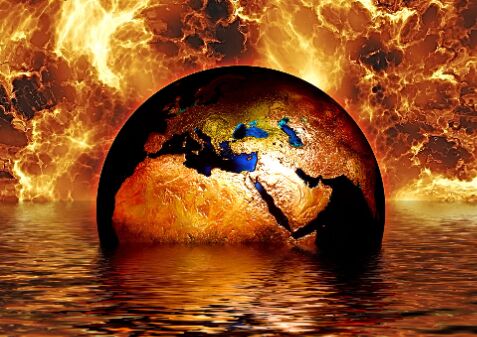Breaking the mould
As the UNFCCC members meet in Glasgow in November, parties should negotiate climate change in a manner that incorporates innovative solutions

The climate change negotiations have been held periodically under the banner of the United Nations Forum for Convention on Climate Change (UNFCCC) over the last three decades among the participating countries through Conferences of Parties (CoP). The next CoP is 26th in number ever since the dialogues began on climate change. The CoP 26 is scheduled to be held in Glasgow in November 2021 under the Presidentship of the United Kingdom. The former British Cabinet Minister Alok Sharma, who is the chairperson for CoP 26, in his tweet has exhorted the countries to agree to ambitious emission reduction targets that will lead to net-zero emission by 2050. He had red-flagged the sixth report of the Intergovernmental Panel on Climate Change (IPCC), 2021. World leaders will arrive in Glasgow like a jamboree and meet with several thousand negotiators, government representatives, businesses and citizens for 12 days of talks.
Six years after the Paris climate accord was signed in CoP 21 in 2015, the upcoming CoP is of immense value in terms of opportunity for united human action in view of a very clear and forthright sixth assessment report of IPCC which was published recently. One of the important features of this year's CoP will be taking stock of the Nationally Determined Contributions (NDCs) of the countries, which they were asked to bring after five years at the time of signing the Paris agreement. One of the issues will be to see how countries are going to fare in controlling the rise in atmospheric temperature to 1.5 degree Celsius. The countries in CoP 26 will have to agree to step up actions to phase out coal, curtail deforestation, speed up switching to electric vehicles and encourage investment in renewables. Further, apart from mobilizing finances through international institutions for climate change adaptations, it will be necessary to build warning systems and resilient infrastructure and agriculture to avoid loss of homes, livelihoods and even lives.
The sixth report of IPCC has been one of the best and up-to-date physical understanding of climate, based on the latest advances in science from multiple sources viz. land and sea, measurements from satellites, and data drawn from climate proxy estimates. The report indicates long-term changes in the Earth's climate. It clearly proves that during 2015-2021, each subsequent year has been hotter than the previous one and the year 2021 is proving to be the sixth hottest year ever recorded. The report states that global warming has constantly increased during the previous four decades compared to 80 years before. It vividly describes the human activities responsible for this rise in temperature and consequent climatic vagaries being noticed every year, with increasing intensity resulting in acute hardship to the poor and disadvantaged sections of the world population.
It would be interesting to quote the very serious sentences of the IPCC sixth assessment report for larger public demonstration and a stern warning to the policymakers. It says "Observed changes in the atmosphere, oceans, cryosphere and biosphere provide unequivocal evidence of a world that has warmed. Over the past several decades, key indicators of the climate system are increasingly at levels unseen in centuries to millennia, and are changing at rates unprecedented in at least the last 2,000 years." Specifically, global mean surface temperature has increased by 1.09 degree Celsius between the pre-industrial baseline period of 1850-1900 and the most recent decade of 2011-20. This was more likely than not the warmest in roughly 1,25,000 years. Similarly, the rainfall pattern will change to extremities in volume and intensity, resulting in excessive rainfall within a few days and then prolonged droughts all over the world. As for sea ice between the decades of 1979-88 and 2010-19, the average monthly August-October Arctic sea ice area shrunk by around one quarter with a loss of around 2m square kilometres of ice.
In a nutshell, this assessment of IPCC is a grim reminder for the world leaders to accept climate change as a war waged by humanity on nature and it must be tackled on a war footing. The situation demands an immediate time-bound action plan for the next 5 to 10 years by the nations to achieve the targets set by the Paris deal for 2030 and beyond, with further improving the compliances. In this regard, the United States, after returning to the negotiation table, must shoulder the responsibility to lead the developed world to show real commitment as they have the historical responsibility to give rise to the occasion.
In this regard, the negotiators must take lessons from 'Carbix' — a company co-founded by an Indian, Vinit Dighe, and J Sammy at Quincy Massachusetts USA. They develop reactors to harness carbon dioxide from emission streams generated by waste-to-energy plants, geothermal plants, water desalination and natural gas plants. They target cement manufacturing which alone contributes to eight per cent of carbon emissions. They use these emissions to produce minerals like calcium carbonate and limestone, while at the same time remaining carbon negative. It is like catching the emissions and converting them into valuable minerals. There is a huge scope for a permanent carbon sequestration market. It would be appropriate if the Environment Minister, Bhupendra Yadav, invites the Indian innovator who is breaking new grounds on climate change mitigation to have a tie-up with Indian Industries to produce minerals out of emissions. If done, India could be a world leader not only in climate change innovation but effectively controlling the pollutants and using the pollution as a raw material for mineral production.
The writer is Chairman of the Centre for Resource Management and Environment. Views expressed are personal



